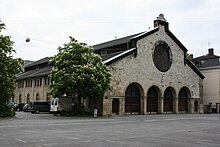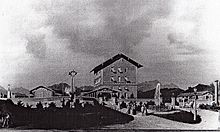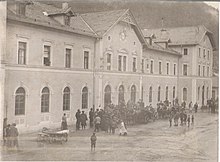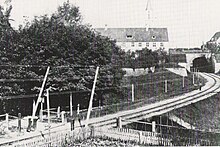Ludwig-Süd-Nord-Bahn
The Ludwig-Süd-Nord-Bahn was built by the Royal Bavarian State Railways as the first state railway between 1843 and 1854 and opened in sections. It got its name from King Ludwig I (Bavaria) , who initially advocated his Ludwig-Danube-Main Canal more than railways. The route leads from Lindau via Immenstadt , Kempten , Augsburg , Donauwörth , Nördlingen , Nuremberg , Bamberg , Kulmbach to Hof . There was a connection to the Saxon-Bavarian Railway to Leipzig.
history
After the Ludwigseisenbahn lines from Nuremberg to Fürth and the Munich-Augsburg Railway Company , which were built and operated with private funds, had been successful, Bavarian railway committees for the construction of private railway lines were founded in many places. However, the Bavarian state decided to tackle the construction of further railway lines as a state task. On January 14, 1841, he signed a contract with the Kingdom of Saxony and the Duchy of Saxony-Altenburg to build a railway line from Leipzig to Nuremberg with a border crossing at Hof and the obligation for all partners to complete this line within six years. In Bavaria it was decided to continue this railway line via Augsburg and Kempten to Lindau on Lake Constance. The law to build the railway line, which was named Ludwigs-Süd-Nord-Bahn, was passed in Munich on August 25, 1843. At a cost of 51.5 million guilders , the entire line should be completed within ten years. For the Augsburg – Hof section, 33 million guilders had been calculated. For the time being, only one track was to be laid on a substructure prepared for two tracks. The construction management of the line took over on July 1, 1841 chief engineer Friedrich August von Pauli and the royal district building officer Paul Camille von Denis , who, however , resigned in 1842 and took over the construction of the Palatinate railways.
Track construction
Lindau – Augsburg
Work on the Bavarian Maximiliansbahn in the direction of Ulm began in Augsburg while the southern section was still being built, the last part of which is now also known as the Allgäu Railway . Their first section to Dinkelscherben was opened on September 26, 1853.
In Kempten, the route was led on a high, double-track wooden bridge, the König-Ludwig-Brücke , over the Iller and ended in a terminus in front of the city. It was not until 1906 that the wooden bridge was replaced by a concrete bridge built next to it . The still existing King Ludwig Bridge is the last truss bridge in Germany, which was built according to plans by the American William Howe . Seven kilometers further in the direction of Immenstadt, another 53 meter long wooden bridge was built over the Waltenhofer Tobel, which was replaced by a steel bridge in 1900.
At Röthenbach in the Allgäu , the world's largest railroad embankment was built between 1847 and 1853. As a job creation measure, ordered by King Max II, the 901 m long and 53 m high dam was created with a base width of 260 m and a crown width of 22 m, 2.24 million cubic meters of earth were moved. Hundreds of workers were employed in the construction, 44 of whom lost their lives. On the route towards Lindau, the train runs over two passes. In this way the builders avoided touching the "foreign" Württemberg .
From Aeschach the route leads on the Lindau Bodenseedamm to Lindau.
The last six stages of the route opened as follows:
| Part of the route | length | in operation from |
|---|---|---|
| Augsburg - Kaufbeuren | 60.2 km | September 1, 1847 |
| Kaufbeuren– Kempten | 42.5 km | April 1, 1852 |
| Kempten– Immenstadt | 21.7 km | May 1, 1853 |
| Immenstadt - Oberstaufen | 16.9 km | September 1, 1853 |
| Oberstaufen – Aeschach | 49.7 km | October 12, 1853 |
| Aeschach– Lindau station. | 1.8 km | March 1, 1854 |
The entire stretch from Hof to Lindau, with a length of around 566 kilometers, was completed on March 1, 1854, 11 years after construction began, a great achievement with the funds available at the time. Today the line is mostly double-tracked.
- Route item
Augsburg – Nuremberg
Construction began in the middle section in 1843. However, the two bridges over Wertach and Danube in Augsburg and Donauwörth hampered rapid expansion. The Munich-Augsburger Eisenbahn-Gesellschaft was nationalized on June 1, 1846 to connect this state railway line with the state capital . The Bavarian state paid their shareholders a severance payment of 4.4 million guilders.
The central section with a length of 170 kilometers went into operation in seven stages:
| Part of the route | length | in operation from |
|---|---|---|
| Oberhausen - Nordheim b. Donauwörth | 36.3 km | November 20, 1844 |
| Augsburg- Oberhausen | 2.5 km | July 1, 1846 |
| Nordheim b. Donauwörth – Danube Bridge– Donauwörth | 2.0 km | September 15, 1847 |
| Schwabach– Nuremberg | 15.0 km | April 1, 1849 |
| Donauwörth– Oettingen | 42.4 km | May 15, 1849 |
| Oettingen - Gunzenhausen | 26.5 km | August 20, 1849 |
| Gunzenhausen – Schwabach | 45.5 km | October 1, 1849 |
The detour via Nördlingen was chosen because it was hoped that there would be a connection to the Württemberg railway network and the Franconian Alb between Treuchtlingen and Donauwörth made the construction and operation of the line seem uneconomical for the conditions at the time. In Donauwörth the route led through a 125 meter long tunnel (second oldest tunnel in Bavaria). In 1877 the original route through the urban area of Donauwörth was abandoned. The former Donauwörth train station was north of the Hotel Krebs (now a medical center). From the train station you could get to the ship landing stage on the Danube with regular services to Regensburg etc. The previous route can be traced very well with the help of topographical maps and can also be hiked or cycled in large areas. Some of the old dams can still be seen.
- Route item
- Augsburg – Nördlingen railway line
- Nördlingen – Pleinfeld railway line
- Treuchtlingen – Nuremberg railway line
Nuremberg – Hof

In Saxony , the private Saxon-Bavarian Railway Company , in which the Kingdom of Saxony and Saxony-Altenburg had a 25% stake, began construction in 1841 . In Bavaria, the Royal Railway Construction Commission in Nuremberg was founded in 1841 and the acquisition of land began in 1842. The construction of the line began in 1843. The reason for this late start of construction was the search for a route with not too great inclines and at the same time connecting as many Bavarian locations as possible. As a result, in addition to a few detours, one also had to accept the inclined plane on the Münchberg plateau near Neuenmarkt - Wirsberg with an average gradient of 23 ‰.
The northern section of the Ludwigs-Süd-Nord-Bahn was opened with a length of 203 kilometers in five stages:
| Part of the route | length | in operation from |
|---|---|---|
| Nuremberg - Bamberg | 62.4 km | September 1, 1844 freight traffic, October 1, 1844 passenger traffic |
| Bamberg- Lichtenfels | 31.9 km | February 15, 1846 |
| Lichtenfels - Neuenmarkt | 42.5 km | October 15, 1846 |
| Neuenmarkt– Hof | 52.9 km | November 1, 1848 |
| Hof – Saxon border | 13.0 km | November 20, 1848 |

The opening ceremony for the first section took place in Nuremberg on August 25, 1848, the king's birthday. Neither in Bavaria nor in Saxony could the agreed construction period of six years be adhered to. In Saxony there were delays mainly due to the large engineering structures over Elster and Göltzschtal , which led to the bankruptcy of the private railway company. The line was only opened there in 1851 - now as a Saxon state railway. In Erlangen , where the line runs parallel to the Ludwig-Main-Danube Canal , it passes through the 306-meter-long Burgberg tunnel, the oldest railway tunnel in Bavaria. In Bamberg, from 1852, the Ludwigs-West-Bahn connected via Würzburg to Aschaffenburg . In Hof the line ended in a terminus station until 1880 ,
The south-north railway initially affected Fürth in the east. After the stop in Doos it crossed the Ludwigseisenbahn at the same height and ran north via Poppenreuth , Neuronhof and Ronhof to the Großgründlach stop . In 1865 the Nuremberg – Würzburg railway was opened, which was run jointly with the South-North Railway to Doos and crossed Fürth quite centrally. In 1876 it was decided to build the “Fürther Bogen”. The Ludwig South-North Railway chain west of the Seven Arch Bridge over the Rednitz in a wide arc to the north over Unterfarrnbach, with a bridge over the Regnitz , the station Vach in barns and a bridge over the Ludwig Canal at Herboldshof from and met the original route to Großgründlach.
- Route item
The south-north railway today
Southern section
On the southern section, the route between Lindau and Buchloe is still an important supra-regional connection from Vorarlberg and Switzerland to Germany. When the Arlbergbahn is closed , mostly due to weather conditions , the trains of the Austrian Federal Railway from Vorarlberg to Vienna are diverted via this route.
Middle section
In the middle section, the south-north line has not been used continuously as the main connection since the Donauwörth – Treuchtlingen railway line opened in 1906 . The Augsburg – Donauwörth and Pleinfeld – Nuremberg sections were electrified in 1935. The section from Donauwörth via Nördlingen and Gunzenhausen to Pleinfeld remained single-track. In 1985, passenger and freight traffic was discontinued on the Nördlingen – Gunzenhausen railway line . Re-used as a museum railway , freight traffic was resumed there in 2004.
Northern section
In the northern section, only the connection from Nuremberg to Hochstadt-Marktzeuln - where the Frankenwaldbahn branches off - is of national importance.
There are some relics of the abandoned original route of the south-north railway east of Fürth:
- Dams west of Großgründlach
- Cuts east of Steinach, now a chain of ponds in the Schmalau industrial park,
- the Starenweg in Ronhof and a farm road in Poppenreuth
- the stone arch bridge at Doos over the Pegnitz , which was used as a road bridge (Dooser Straße) and was demolished in 1963 in favor of the new Kurgartenbrücke.
A planned swiveling of the S-Bahn to Forchheim via the Schmalau industrial park would bring the railway back to part of the old route.
literature
- Carl Asmus, Gerhard Zimmermann, Helge Hufschläger: Railways in the Allgäu . 3 parts. Merker, Fürstenfeldbruck 1991–1994, ISBN 3-922404-44-8 (part 2), ISBN 3-922404-31-6 (part 3) (also: Eisenbahn-Journal Special-Ausgabe 1991, 4; 1993, 2 ; 1994, 1 ISSN 0720-051X ).
- Markus Hehl: Railway in the Allgäu. 150 years of the Ludwig-Süd-Nord-Bahn . EK-Verlag, Freiburg im Breisgau, 1993 ( Eisenbahn-Kurier Spezial 46, ISSN 1434-3045 ).
- Wolfgang Klee, Ludwig von Welser: Bavaria Report . Volumes 1-9. Merker, Fürstenfeldbruck 1993–2001,
- Vol. 1: Wolfgang Klee: Bavarian Railway History . Part 1: 1835-1875 . 1993, ISBN 3-922404-43-X ,
- Vol. 2: Wolfgang Klee: Bavarian Railway History . Part 2: 1875-1920 . 1994, ISBN 3-922404-61-8 ,
- Vol. 3: Wolfgang Klee: Track plans and route history . 1995, ISBN 3-922404-62-6 ( Eisenbahn-Journal Archiv 95, 3),
- Vol. 4: Ludwig von Welser: The genera AI to AV, BI to B VI, CI and C II . 1994, ISBN 3-922404-69-3 ,
- Vol. 5: Ludwig von Welser: The genera B VII to B IX, C III, DI to D VII and the locomotives of the Eastern Railway . 1995, ISBN 3-922404-78-2 ( Eisenbahn-Journal Archiv 95, 4),
- Vol. 6: Ludwig von Welser: The genera BX, B XI, AA I, S 2/5 Vaucl., C IV to C VI, BB I, EI, EI Vaucl. and G 4/5 N . 1996, ISBN 3-922404-94-4 ( Eisenbahn-Journal Archiv 96, 4),
- Vol. 7: Ludwig von Welser: The genera BB II, D II, D VIII to D XII, R 4/4, PtzL 3/4, LE, Gts 4/4, Pts 3/4 and Gts 2 × 3/3 . 1997, ISBN 3-89610-011-4 ( Eisenbahn-Journal Archiv 97, 3),
- Vol. 8: Ludwig von Welser, Helge Hufschläger: The genera Pt 2/3, Pt 2/4 N, Pt 2/4 H, Pt 3/6, Gt 2 × 4/4, PtL 2/2, GtL 4 / 4, GtL 4/5 Mod. And MCCi . 1999, ISBN 3-89610-049-1 ( Eisenbahn-Journal Archiv 99, 2),
- Vol. 9: Ludwig von Welser, Helge Hufschläger: The genera S 3/5 N, S 3/5 H, S 2/5, S 2/6, (S 3/6), P 3/5 N, P 3 / 5 H, G 5/5, G 4/5 H, G 3/4 . 2001, ISBN 3-89610-081-5 ( Eisenbahn-Journal Archiv 2001, 2).
- Stephan Kuchinke: The Ludwigs-Süd-Nordbahn from Lindau to Hof . Transpress, Stuttgart 1997, ISBN 3-613-71064-1 .
- Steffen Lüdecke: The Inclined Plane. A legendary railway line . EK-Verlag. Freiburg im Breisgau 1993, ISBN 3-88255-833-4 .
- Deutsche Reichsbahn: The German railways in their development 1835–1935 . Reichsdruckerei, Berlin 1935.
- Günther Scheingraber: The Royal Bavarian State Railways. Your locomotives and wagons in words and pictures . Franckh, Stuttgart 1975, ISBN 3-440-04233-2 .
- Beatrice Sendner-Rieger: The stations of the Ludwig-Süd-Nord-Bahn 1841-1853. On the history of the Bavarian state building system in the 19th century . German Society for Railway History V., Karlsruhe 1989, ISBN 3-921700-57-4 (also: Bern, Univ., Diss., 1986).
- Walther Zeitler, Helge Hufschläger: The railway in Swabia. History, operation, technology. 1840 until today . Motorbuch-Verlag, Stuttgart 1980, ISBN 3-87943-761-0 .







